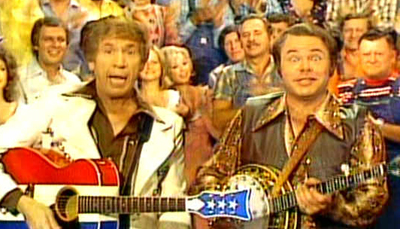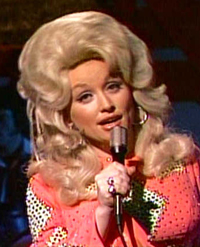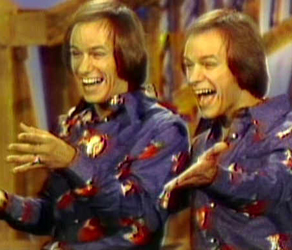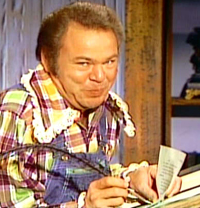
I’m always amazed by the crap that people hold onto. I have a lot of enthusiasms — music, comics, film — but I’ve never had the urge to be a completist about any of it. Every year or so, I sort through the stuff I’ve accumulated and put together a big box of books I know I’ll never re-read and DVDs I’m unlikely to re-watch, and off they go to the Salvation Army. And I don’t buy that many books and videos to begin with; I already invested most of my 1990s Fridays in watching The X-Files — why would I want to watch it again on DVD?
 Which is a roundabout way of saying that I started this project baffled as to how anybody might think that Hee Haw was worth preserving for the ages. But sure enough, the good folks at Time-Life Video have an extensive collection of episodes for sale.
Which is a roundabout way of saying that I started this project baffled as to how anybody might think that Hee Haw was worth preserving for the ages. But sure enough, the good folks at Time-Life Video have an extensive collection of episodes for sale.
Now, admittedly, I’m not the target audience here. I grew up in New England, which was for a long time the one place where country & western couldn’t find a commercial toehold. A middle-class suburban kid like me could watch Hee Haw in syndication, just as with Lawrence Welk and Soul Train, and like them it seemed like a glimpse into a parallel musical universe. Indeed, I thought of Hee Haw as being sort of like Soul Train for rural whites.
But surely Soul Train never condescended to its intended audience as Hee Haw did to its. What I remember of the show is mostly gawping hillbilly stereotypes, popping up amongst plywood cornstalks to deliver jokes that were stale when God was a boy. Who, exactly was meant to be laughing at this, and why?
I’ve since come around on country music, as I have on soul and funk (sorry, Lawrence Welk). It’s still not my favorite genre of pop, but I’ve got a lot of time for the craftsmanship, the professionalism, the care and energy that goes into presentation and branding — so much art to make it all look artless. Roy Clark had some fine instrumental chops to go with those lush sideburns; and Buck Owens — well, not only did Buck help create the Bakersfield Sound, he palled around with Ringo, for cryin’ out loud! Looking at it now, Hee Haw‘s musical pedigree looks downright promising.

And the show ran for 24 years in syndication, so obviously somebody thought it was worth watching — and worth preserving on DVD. And there are legion of fans who remember the show with fondness. Had I been wrong, all this time? I have no interest in taking cheap shots, so I decided to revisit the show with an open mind. Was Hee Haw better than I remembered? Were all those frightening teeth for real? Was Junior Samples really some kind of unappreciated deadpan-comic genius? I grabbed a disc at random from The Hee Haw Collection — episode #152, from 1974 — and settled in to see what I’d been missing.
Oh my. Oh, my, my, my.
In the wake of the rightward tilt in American politics, Thomas Frank wrote a book called What’s The Matter With Kansas? Frank wondered why it was that red-state Americans tended to vote overwhelmingly for the party whose trade policies were the very things squeezing the heartland the worst — in other words, how so many people could vote against their own economic interests. Assuming that it was this same demographic that kept Hee Haw on the air for a quarter-century, I think I can safely answer Frank: The matter is that rural America has a self-loathing streak a mile wide, and is possessed of a nearly boundless appetite for insult.
Remember the movie Cast Away, where Tom Hanks is stranded on a desert island with a stack of video cassettes, and he braids the tapes into a rope with which to hang himself? That would be a better use for the Hee Haw master tapes. And believe me, by the end of just one episode, I felt inclined to stick my head in a noose.
 There are some genuine musical pleasures here — Clark dresses up “Gentle On My Mind” with a stinging manouche guitar solo; the late Terry McMillan makes a righteous rip through “The Orange Blossom Special”; Dolly Parton, her hair at its largest and most immobile, cuts through to the heart of “I Will Always Love You” with an achingly simple, genuine performance. But these moments are so fleeting, they’re like flashes of gold in a panful of mud.
There are some genuine musical pleasures here — Clark dresses up “Gentle On My Mind” with a stinging manouche guitar solo; the late Terry McMillan makes a righteous rip through “The Orange Blossom Special”; Dolly Parton, her hair at its largest and most immobile, cuts through to the heart of “I Will Always Love You” with an achingly simple, genuine performance. But these moments are so fleeting, they’re like flashes of gold in a panful of mud.
Elsewhere, Hugh Hefner arm-candy Barbi Benton sings as if heavily sedated, head lolling alarmingly from side to side; the Hager Twins — floral shirts, obscenely tight pants, and matching Brian Eno hairlines — are pure nightmare fuel; and the session cats in the backing band alternate between indulgent smiles and aggrieved glowers while hacking it out strictly by the numbers.

The worst offender, sadly, is Buck Owens. He’s still got charm to spare, but to call his performances “perfunctory” would be a compliment. Owens had gone beyond simply phoning in his act; by this point, his act was sending prepared statements to be read by a spokesman.
Roy Clark, for better or worse, at least seems fully engaged. Unfortunately, this means that he treats us to a mean little gay-baiting sketch, lisping and mincing about with lacy frills sewn onto his overalls, to hoots of canned laughter. It’s an ugly moment — ugly in 1974 and uglier now.
 The best that can be said of the sketch is that it’s over quickly. They all are; Hee Haw cribs most of its style, if not its substance, from Rowan and Martin’s Laugh-In — all catchphrase-based humor, two-liners, and rapid-fire editing. It seems an unlikely model, but an extended radio-host routine gives the game away, with its clear echoes of Gary Owens‘ shtick.
The best that can be said of the sketch is that it’s over quickly. They all are; Hee Haw cribs most of its style, if not its substance, from Rowan and Martin’s Laugh-In — all catchphrase-based humor, two-liners, and rapid-fire editing. It seems an unlikely model, but an extended radio-host routine gives the game away, with its clear echoes of Gary Owens‘ shtick.
The line on Hee Haw was that rural audiences dug it because it seemed genuine — plain country folks, laughing at themselves. The show maintained that illusion by co-opting figures from an earlier era of country & western culture, like Minnie Pearl. But the faÁ§ade is unconvincing. At a couple of points in this episode, we see, poking out from under Buck Owens’ workshirt-and-overall ensemble, a pair of black patent-leather boots, freshly shined, gleaming incongruously. That’s Hee Haw in a nutshell; a bunch of showbiz phonies playing dress-up, and their disrespect for the audience runs so deep that they don’t even bother to do a decent job of faking it.





Comments